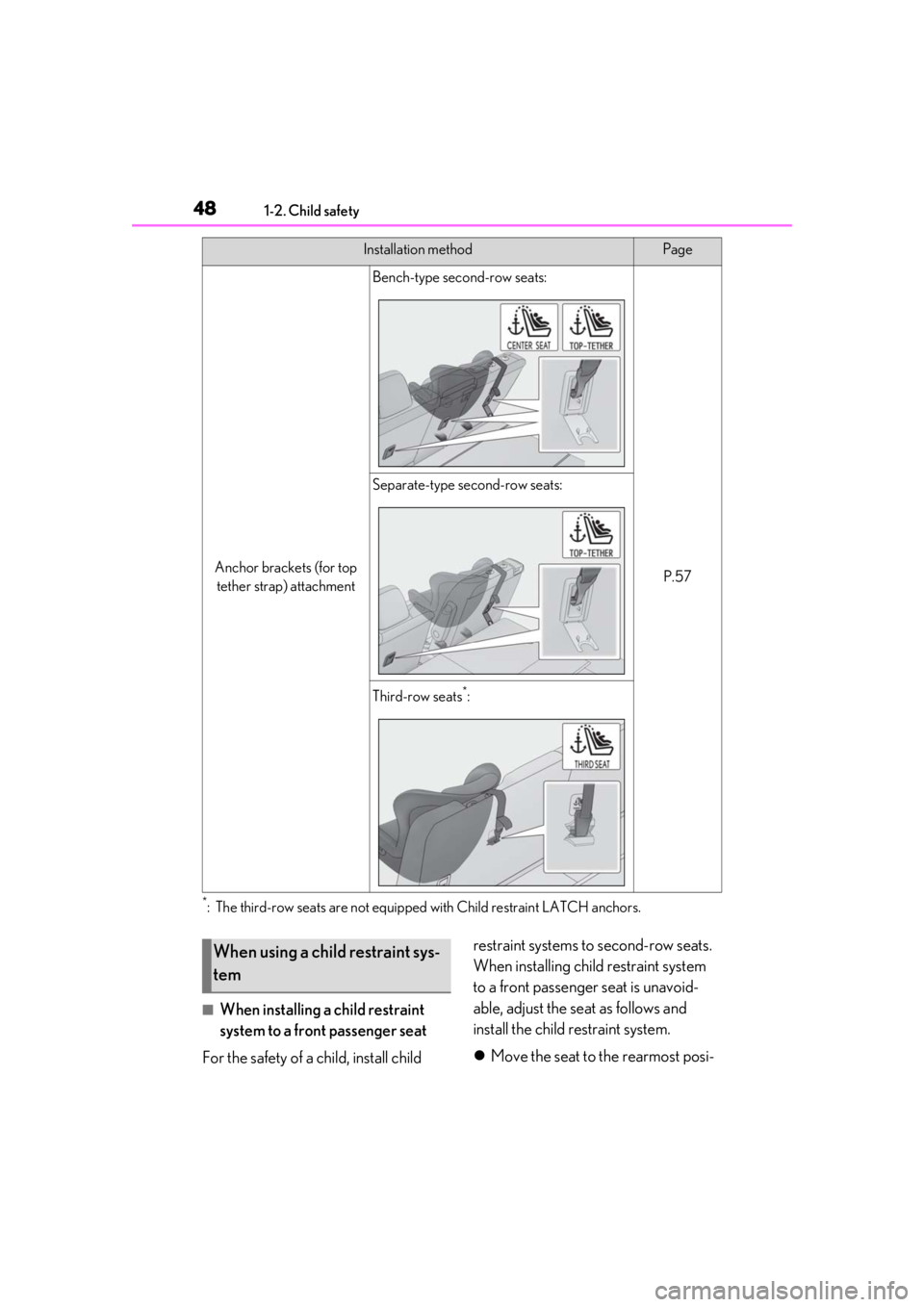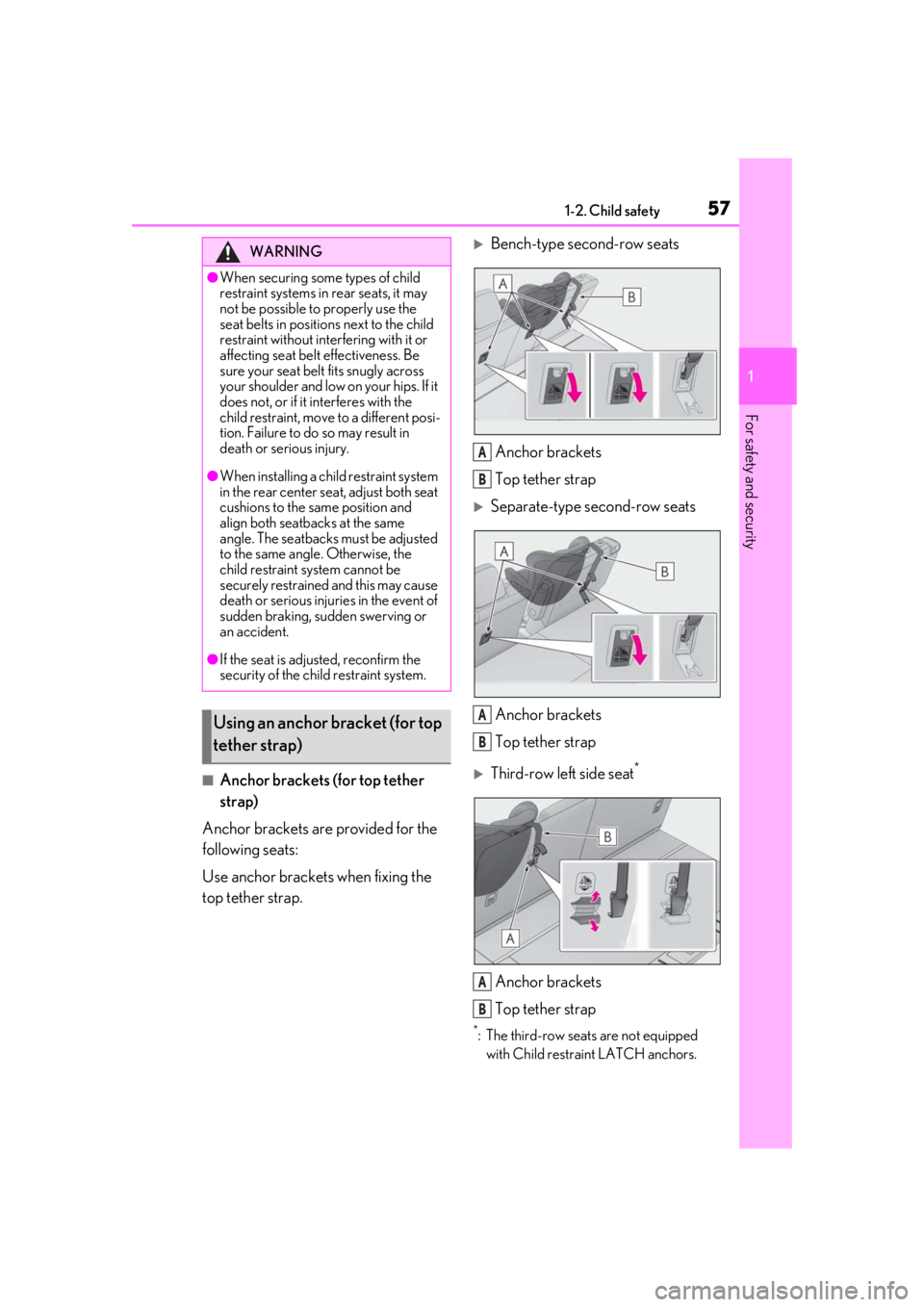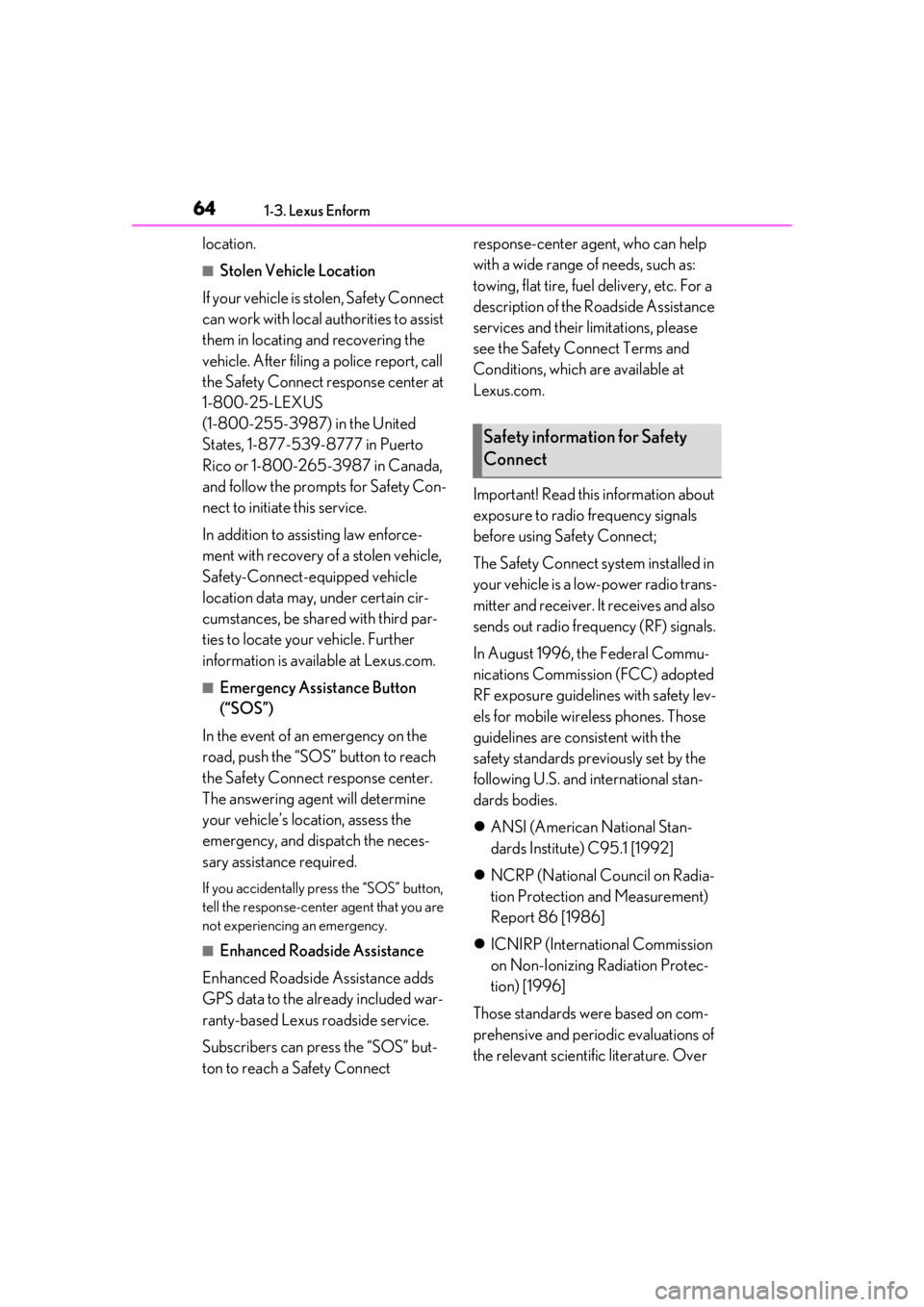2021 LEXUS RX350 equipped
[x] Cancel search: equippedPage 33 of 508

331-1. For safe use
1
For safety and security
RX350L: Rear side airbags (outboard second-row seats)
Your vehicle is equipped with ADVANCED AIRBAGS designed based on the US
motor vehicle safety standards (FMVSS208). The airbag sensor assembly (ECU)
controls airbag deployment based on information obtained from the sensors etc.
shown in the system components diagram above. This information includes crash
severity and occupant information. As the airbags deploy, a chemical reaction in
the inflators quickly fills the airbags with no n-toxic gas to help restrain the motion of
the occupants.
■If the SRS airbags deploy (inflate)
●Slight abrasions, burns, bruising etc., may
be sustained from SRS airbags, due to the
extremely high speed deployment (infla-
tion) by hot gases.
●A loud noise and white powder will be
emitted.
●Parts of the airbag module (steering
wheel hub, airbag cover and inflator) as
well as the front seat s, parts of the front
and rear pillars, and roof side rails, may
be hot for several minutes. The airbag
itself may also be hot.
●The windshield may crack.
●All of the doors will be unlocked.
( P.100)
●The brakes and stop lights will be con-
trolled automatically. ( P.275)
●The interior lights will turn on automati-
cally. ( P.310)
●The emergency flashers will turn on auto-
matically. ( P.394)
●Fuel supply to the engine will be stopped.
( P.402)
●For Lexus Enform Safety Connect sub-
scribers, if any of the following situations
occur, the system is designed to send an
emergency call to the response center,
notifying them of the vehicle’s location
(without needing to push the “SOS” but-
ton) and an agent will attempt to speak
with the occupants to ascertain the level
of emergency and assi stance required. If
the occupants are unable to communi-
cate, the agent automatically treats the
call as an emergency and helps to dis-
patch the necessary emergency services. (
P.60)
• An SRS airbag is deployed.
• A seat belt pretensioner is activated.
• The vehicle is involved in a severe rear-end collision.
■SRS airbag deployment conditions (SRS
front airbags)
●The SRS front airbags will deploy in the
event of an impact that exceeds the set
threshold level (the level of force corre-
sponding to an approximately 12 - 18
mph [20 - 30 km/h] frontal collision with
a fixed wall that does not move or
deform).
However, this threshol d velocity will be
considerably higher in the following situa-
tions:
• If the vehicle strikes an object, such as a parked vehicle or sign pole, which can
move or deform on impact
• If the vehicle is involved in an underride collision, such as a collision in which the
front of the vehicle “underrides”, or goes
under, the bed of a truck
●Depending on the type of collision, it is
possible that only the seat belt preten-
sioners will activate.
●The SRS seat cushion airbag on the front
passenger seat will not operate if the
occupant is not wearing a seat belt.
■SRS airbag deployment conditions (SRS
side and curtain shield airbags)
●The SRS side and curtain shield airbags
will deploy in the event of an impact that
exceeds the set threshold level (the level
of force corresponding to the impact
force produced by an approximately
3300 lb. [1500 kg] vehicle colliding with
the vehicle cabin from a direction per-
Page 39 of 508

391-1. For safe use
1
For safety and security
WARNING
●Installation of electronic devices such
as mobile two-way radios and CD
players
●Modifications to your vehicle for a per-
son with a physical disability
Front passenger occupant
classification system
Your vehicle is equipped with a
front passenger occupant classifi-
cation system. This system detects
the conditions of the front passen-
ger seat and activates or deacti-
vates the devices for the front
passenger.
Page 48 of 508

481-2. Child safety
*: The third-row seats are not equipped with Child restraint LATCH anchors.
■When installing a child restraint
system to a front passenger seat
For the safety of a child, install child restraint systems to second-row seats.
When installing child restraint system
to a front passenger seat is unavoid-
able, adjust the seat as follows and
install the child restraint system.
Move the seat to the rearmost posi-
Anchor brackets (for top
tether strap) attachment
Bench-type second-row seats:
P.57
Separate-type second-row seats:
Third-row seats*:
Installation methodPage
When using a child restraint sys-
tem
Page 57 of 508

571-2. Child safety
1
For safety and security
■Anchor brackets (for top tether
strap)
Anchor brackets are provided for the
following seats:
Use anchor brackets when fixing the
top tether strap.
Bench-type second-row seats
Anchor brackets
Top tether strap
Separate-type second-row seats
Anchor brackets
Top tether strap
Third-row left side seat*
Anchor brackets
Top tether strap
*: The third-row seats are not equipped with Child restra int LATCH anchors.
WARNING
●When securing some types of child
restraint systems in rear seats, it may
not be possible to properly use the
seat belts in position s next to the child
restraint without inte rfering with it or
affecting seat belt effectiveness. Be
sure your seat belt fits snugly across
your shoulder and low on your hips. If it
does not, or if it interferes with the
child restraint, move to a different posi-
tion. Failure to do so may result in
death or serious injury.
●When installing a child restraint system
in the rear center seat, adjust both seat
cushions to the same position and
align both seatbacks at the same
angle. The seatbacks must be adjusted
to the same angle. Otherwise, the
child restraint system cannot be
securely restrained and this may cause
death or serious injuri es in the event of
sudden braking, sudden swerving or
an accident.
●If the seat is adju sted, reconfirm the
security of the child restraint system.
Using an anchor bracket (for top
tether strap)
A
B
A
B
A
B
Page 60 of 508

601-3. Lexus Enform
1-3.Lexus Enform
*:If equipped
“SOS” button
LED light indicators
Microphone
Lexus Enform Safety Con-
nect*
Safety Connect is a subscrip-
tion-based telematics service that
uses Global Positioning System
(GPS) data and embedded cellular
technology to provide safety and
security features to subscribers.
Safety Connect is supported by
Lexus’ designated response center,
which operates 24 hours per day, 7
days per week.
Safety Connect service is available
by subscription on select, telemat-
ics hardware-equipped vehicles.
By using the Safety Connect ser-
vice, you are agreeing to be bound
by the Telematics Subscription Ser-
vice Agreement and its Terms and
Conditions, as in effect and
amended from time to time, a cur-
rent copy of which is available at
Lexus.com. All use of the Safety
Connect service is subject to such
then-applicable Terms and Condi-
tions.
System components
A
B
C
Page 64 of 508

641-3. Lexus Enform
location.
■Stolen Vehicle Location
If your vehicle is stolen, Safety Connect
can work with local authorities to assist
them in locating and recovering the
vehicle. After filing a police report, call
the Safety Connect response center at
1-800-25-LEXUS
(1-800-255-3987) in the United
States, 1-877-539-8777 in Puerto
Rico or 1-800-265- 3987 in Canada,
and follow the prompts for Safety Con-
nect to initiate this service.
In addition to assisting law enforce-
ment with recovery of a stolen vehicle,
Safety-Connect-equipped vehicle
location data may, under certain cir-
cumstances, be shared with third par-
ties to locate your vehicle. Further
information is available at Lexus.com.
■Emergency Assistance Button
(“SOS”)
In the event of an emergency on the
road, push the “SOS” button to reach
the Safety Connect response center.
The answering agent will determine
your vehicle’s location, assess the
emergency, and dispatch the neces-
sary assistance required.
If you accidentally press the “SOS” button,
tell the response-center agent that you are
not experiencing an emergency.
■Enhanced Roadside Assistance
Enhanced Roadside Assistance adds
GPS data to the already included war-
ranty-based Lexus roadside service.
Subscribers can press the “SOS” but-
ton to reach a Safety Connect response-center agent, who can help
with a wide range of needs, such as:
towing, flat tire, fuel delivery, etc. For a
description of the Roadside Assistance
services and their limitations, please
see the Safety Connect Terms and
Conditions, which are available at
Lexus.com.
Important! Read this information about
exposure to radio frequency signals
before using Safety Connect;
The Safety Connect system installed in
your vehicle is a low-power radio trans-
mitter and receiver. It receives and also
sends out radio frequency (RF) signals.
In August 1996, the Federal Commu-
nications Commission (FCC) adopted
RF exposure guidelines with safety lev-
els for mobile wireless phones. Those
guidelines are consistent with the
safety standards previously set by the
following U.S. and international stan-
dards bodies.
ANSI (American National Stan-
dards Institute) C95.1 [1992]
NCRP (National Council on Radia-
tion Protection and Measurement)
Report 86 [1986]
ICNIRP (International Commission
on Non-Ionizing Radiation Protec-
tion) [1996]
Those standards were based on com-
prehensive and periodic evaluations of
the relevant scientific literature. Over
Safety information for Safety
Connect
Page 68 of 508

681-4. Theft deterrent system
■Items to check before locking the
vehicle
To prevent unexpected triggering of
the alarm and vehicle theft, make sure
of the following:
Nobody is in the vehicle.
The windows, moon roof (if
equipped) and panoramic moon
roof (if equipped) are closed before
the alarm is set.
No valuables or other personal
items are left in the vehicle.
■Setting
Close the doors and hood, and lock all
the doors. The system will be set auto-
matically after 30 seconds.
The indicator light changes from being on
to flashing when the system is set.
■Canceling or stopping
Do one of the following to deactivate
or stop the alarm:
Unlock the doors.
Turn the engine switch to ACCES-
SORY or IGNITION ON mode, or
start the engine. (The alarm will be
deactivated or stopped after a few
seconds.)
■System maintenance
The vehicle has a maintenance-free type
alarm system.
■Triggering of the alarm
The alarm may be triggered in the following
situations:
(Stopping the alarm deactivates the alarm
system.)
●For Canada: The doors are unlocked
using the mechanical key.
Alarm
The alarm uses light and sound to
give an alert when an intrusion is
detected.
The alarm is triggered in the follow-
ing situations when the alarm is set:
Except for Canada: A locked
door is unlocked or opened in any
way other than using the entry
function, wireless remote control
or mechanical key. (The doors will
lock again automatically.)
For Canada: A locked door is
unlocked or opened in any way
other than using the entry func-
tion or wireless remote control.
(The doors will lock again auto-
matically.)
The hood is opened.
Setting/canceling/stopping the
alarm system
Page 73 of 508

732-1. Instrument cluster
2
Vehicle status information and indicators
Warning lights inform the driver of mal-
functions in the indicated vehicle’s sys-
tems.
Warning lights
(U.S.A.)
Brake system warning light*1
( P.403)
(red)
(Canada)
Brake system warning light*1
( P.403)
(yellow)
Brake system warning light*1
( P.403)
High coolant temperature
warning light
*2 ( P.403)
Charging system warning
light
*3 ( P.404)
Low engine oil pressure warn-
ing light
*2 ( P.404)
(U.S.A.)
Malfunction indicator lamp*1
( P.404)
(Canada)
Malfunction indicator lamp*1
( P.404)
SRS warning light
*1 ( P.404)
(U.S.A.)
ABS warning light*1 ( P.405)
(Canada)
ABS warning light*1 ( P.405)
Brake Override System warn-
ing light/Drive-Start Control
warning light
*2 ( P.405)
(red)
Electric power st eering system
warning light
*1 ( P.405)
(yellow)
Electric power steering system
warning light
*1 ( P.405)
Low fuel level warning light
( P.406)
Driver’s and front passenger’s
seat belt reminder light
( P.406)
(RX350)
Rear passengers’ seat
belt reminder light
*4
( P.406)
(RX350L)
Rear passengers’ seat
belt reminder
light
*4( P.406)
Tire pressure warning light
*1
( P.407)
(orange)
LTA indicator ( P.407)
(flashes)
Intuitive parking assist OFF indi-
cator
*1 (if equipped) ( P.407)
(flashes)
RCTA OFF indicator*1 (if
equipped) ( P.407)
(flashes)
PKSB OFF indicator*1 (if
equipped) ( P.408)
(flashes or
illuminates)PCS warning light*1 ( P.408)
Slip indicator
*1 ( P.408)
(flashes)
(U.S.A.)
Parking brake indicator
( P.409)
(flashes)
(Canada)
Parking brake indicator
( P.409)